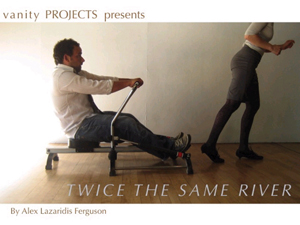Twice the Same River: comic-existentialist romp

Twice the Same River is a comic existentialist romp that tackles the meaning of love, adultery, and identity. Four faithless lovers become entangled in a web of supernatural intrigue that leaves them profoundly confused about the nature of the self and the soul.
The cast of characters consists of Guy, who has tried to strangle his girlfriend Julie after finding her in bed with his friend Benny, whose girlfriend Allyson has conspired with Guy – whom she is in lust – to kill Julie, so that they – Allyson and Guy – can run away together. The fact that Benny was also (very briefly) Guy's lover, is played for humour, but serves to emphasize the sexual and psychological fluidity of characters whose essential insubstantiality explored is at the heart of this play.
A clever script backed by strong performances, well-paced action, and snappy banter, Twice the Same River satirizes contemporary ideals of sexual liberation and social reform. The four young aspiring polyamorous lovers are shown-up as simultaneously lust-afflicted, idealistic, selfish, and indecisive. Characters attempt to murder each other repeatedly, while simultaneously claiming that first one, now the other is the love of her or his life.
Yet not even death is certain in this uncertain world: those who seem dead are brought back to life through tricks of semantics. At one point a deadpan Benny tries to kill Allyson, while quoting Othello – but she is revived on the technicality of a few mis-spoken lines. The plot twists and runs sideways when statements that start out as puns or metaphors become literal and change the course of events.
When a resurrected Julie tries to strangle Guy in retaliation for his attempt to strangle her, the cast find themselves on their way to the underworld, escorted by the philosophically-minded coroner, who acts as a foil to the troubled couples. At one point he corrals them into chairs set along the wall of the morgue, defending the gesture as “an outward expression of an inner desire to find order in chaos.” He acts as guide, narrator, and grand inquisitor, delving into the implications of characters' actions in a manner that it both witty and naïve. He analyses their bodies and their psyches, draws meaning from their confusion and their angry words, and attempts to assemble the fragments into a meaningful whole.
In the end however, meaning seems to elude them every one, and the lights come down on characters who either stand in limbo, are blinded by loneliness, or have acquiesced to their own delusions.
Twice the Same River deviates frequently into the ridiculous – most often by design – and the play's dark humour is generally successful. Unfortunately the penultimate moment of the story – the irreversible suicide of one character – rings a false note in an otherwise tight script. The moment underscores the hopelessness of the character's confused and loveless existence, but it comes abruptly and plays without subtlety. It is as if, having used up all other possible character combinations, the playwright felt that there was nothing left to do, and so killed off the extra player.
Nonetheless, it can still be said that Twice the Same River is a thoughtful play that eschews easy answers.
For showtime information swim here.
Did you see the show? Let us know what you think below.



